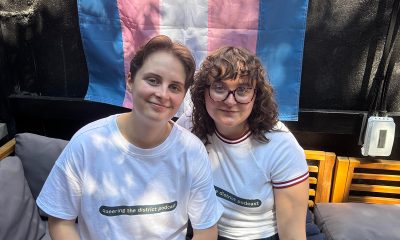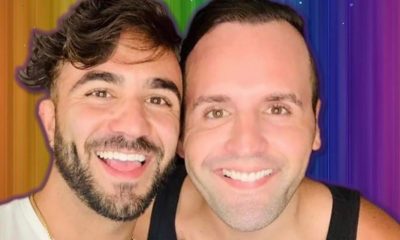a&e features
Gay Holocaust survivor shares life lessons
Alfred Munzer laments ongoing religious, racial hatred
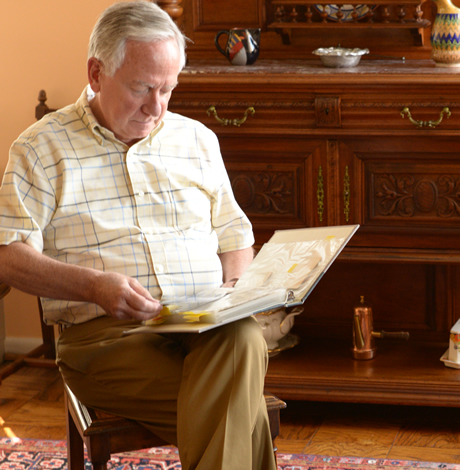
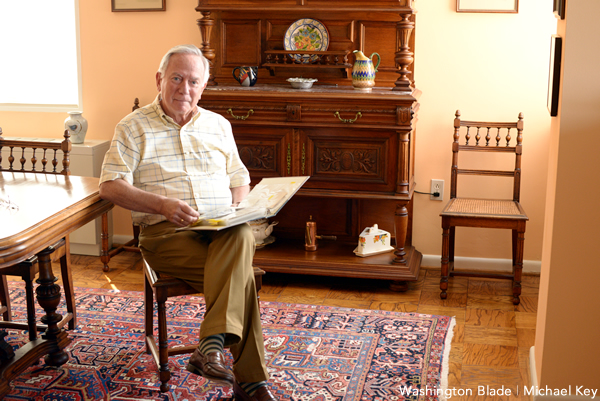
Alfred Munzer in his Van Ness apartment. Now retired from his medical career, Munzer devotes much of his time to the Holocaust Museum. (Washington Blade photo by Michael Key)
First Person 2015 Series: Al Munzer
Conversation with a Holocaust Survivor
Wednesday, July 29
11 a.m.
U.S. Holocaust Memorial Museum
100 Raoul Wallenberg Place, S.W.
Free
No registration required
Although the odds were not favorable for Alfred Munzer in the circumstances surrounding his birth, in many ways, he ended up being the luckiest member of his family.
He’s the youngest of three children of Simcha and Gisele Munzer, a family of Jewish immigrants from what is now Poland. His parents were childhood sweethearts and were raising two daughters, Eva (born in July 1936) and Leah (born in November 1938) in the Hague, Netherlands. After World War I, anti-Semitism was rampant in their native land and opportunities were limited, so they moved to Holland where there was a substantial population of Jews, some of whom were from families that had been there since the 15th century. Simcha ran a men’s tailoring business.
When Gisele discovered she was expecting a third child — the pregnancy was unplanned — an abortion was advised and, as Munzer tells it today, his mother was told that, “it would be immoral to bring another Jewish life into the world.” Although not especially religious, she was inspired by the Old Testament story of Hannah, the childless woman who vows to God that if she is given a son, she will give him back to God. Her wish is granted with the birth of Samuel.
Munzer, now 73, was born on Nov. 23, 1941. Before he reached his first birthday, in July of 1942, Germans began mass deportations of nearly 100,000 Jews from the occupied Netherlands to the east, primarily Auschwitz, a network of Nazi concentration camps in German-annexed regions that had previously been part of Poland. It marked the beginning of a harrowing season for his family.
Munzer says growing up, he was often reminded of the circumstances around which he was born.
“Any time I was bad growing up, my mother would remind me of this, how she had prayed to God and requested a son,” Munzer says. “She indoctrinated me with this. It was made very clear that she had made the same pledge as Hannah and that I was here in service of God ultimately.”
It’s one of many biographical stories Munzer will share on Wednesday, July 29 when he does another installment of the Holocaust Museum’s First Person program in which survivors are interviewed about their life experiences. Since retiring from his career as an internist and pulmonologist last year, Munzer has become increasingly active as a volunteer at the museum. The program is free.
Having shared his life story many times over the years, first at an artistic event in Woodstock, N.Y., in the early 1980s, Munzer says it’s important that his story and those of other Holocaust survivors continue to be told.
“The angle I usually take is that even in a sea of evil, it is possible for people to do the right thing and stand up for what is right,” he says.
Unlike, for instance, the Anne Frank family, the Munzers thought they’d fare better if they went into hiding separately. Munzer’s two sisters went to live with a Catholic family. Simcha Munzer had received a notice to report for so-called labor duty, essentially a one-way ticket to a concentration camp, but was able to delay it by first having a hernia operation he’d been putting off and later faking a suicide attempt. Joined by Gisele at a Jewish psychiatric hospital where she was pretending to be a nurse’s aide, the two were eventually deported, in early 1943, to Vught Concentration Camp and then a year later to Auschwitz where they were separated.
Gisele had sold the family’s possessions. Neighbors kept some items such as a silver candelabra and fire dragon puppet that are now in Munzer’s Van Ness apartment where he’s lived for about 25 years with his husband, Joel Wind. Though only married for a year and a half, the two have been together since they met at Bet Mishpachah, a local LGBT-affirming synagogue where Munzer sometimes preaches, in 1980.
Things quickly turned dark for the family. The husband of the family raising Munzer’s two older sisters turned out to be a Nazi sympathizer. He denounced his wife and the two girls and all three were arrested and sent to the Westerbork transit camp. On Feb. 8, 1944, Eva, 8, and Leah, 6, were deported to Auschwitz where they were killed three days later.
Alfred was put in the care of a family friend named Annie Madna who placed him with her sister. After about a month, she became too nervous to keep him and placed little Alfred with her ex-husband Tole, a native of Indonesia. Munzer stayed there for the next three years and was looked after by their housekeeper, Mima Saina, who went to great lengths to care for him.
“She really became my mother,” Munzer says. “She was a woman who was completely illiterate, who spoke no Dutch, couldn’t read or write, she spoke only Indonesian, but she had a heart of gold. She would walk — I was in the house illegally, so there were no ration coupons for me — she had to scrounge up milk for me however she could, sometimes walking miles just to get it. I’m told I slept in her bed. She kept a knife under the pillow to kill off any Nazis who might try to get me or even kill me rather than having me fall in their hands. She was an amazing woman who raised me from the time I was about 9 months old till I was about 3 and a half.”
Simcha spent several months in Auschwitz and was then sent to three different camps in Austria. Although eventually freed from one in Ebensee in the Austrian Alps by the U.S. Army, he was so weakened by the ordeal that he died under the care of nuns at a convent just two months later, on July 25, 1945, 70 years ago this weekend. Munzer was told his father had contracted tuberculosis.
Gisele fared better and worked on electronics equipment in a series of camps before she was freed at the Danish border through the intervention of the Swedish Red Cross in early 1945. Although fussy from having been awoken from a nap, being reunited with her is one of Munzer’s earliest memories.
“I was cranky and crying so the whole Matna family was passing me around, like you do with a crying baby, and the only lap I wouldn’t sit on was my own mother’s,” Munzer says. “She was a stranger to me by that point.”
It was decided that his de facto surrogate mother Mima would continue to care for him while Gisele looked for work but Mima had a cerebral hemorrhage about two months later and died. Gisele eventually found work in the garment industry. Although deeply traumatized by the Holocaust, Munzer remembers her as a stoic, matter-of-fact woman. He had no sense growing up that his life was any different from anyone else’s.
“I was surrounded by kids who had lost their parents, who had lost siblings, there really was nothing unusual about that,” he says. “I did not understand as a very young kid what had happened to my sisters. All I knew was that there were these beautiful pictures on the wall of these beautiful girls. Everybody would tell me how wonderful they were. One of my mother’s neighbors would tell me that my older sister could write so perfectly when she was just 6. I was a little bit jealous of them in a sense. I had no comprehension of the fact that they had been killed. I just did not understand why they were missing or just didn’t really think about it.”
Neither, too, did the bombed-out landscape of the Hague, strike young Munzer as unusual.
“My mother had a very good friend who was in a concentration camp with her and she and her husband, well, there was very little housing available there. After my mother closed her store, she had acquired a little cosmetics store, we’d go to visit the Van Der Pols in these few little rooms they had in an attic and we’d walk across these huge fields of rubble to get there. I thought walking through rubble was just a normal thing. Or playing hide and seek in bunkers on the beach. It wasn’t until much later that I came to grips with the Holocaust as such.”
In July 1958, Gisele and then-16-year-old Alfred came to the United States where he became a bit of an overachiever. Located in Brooklyn, he finished high school, college, medical school and advance training at Johns Hopkins. He first came to Washington in 1972 during a two-year tour of duty with the Air Force and an assignment at Andrews Air Force Base.
He has many happy memories of his later years with his mother and says the two enjoyed many trips, including a few to visit his father’s grave, in her later years. A pivotal turning point in his understanding of the Holocaust came in 1978 when the miniseries “The Holocaust” aired on CBS.
“Before, I would hear her in conversations with friends and it was always, ‘so-and-so came back’ or ‘so-and-so did not come back.’ They never used the term survived. She had told me little bits and pieces here and there, actually humorous things mostly. She told me once very late in the game, she was actually cast as Adolf Hitler in a play, that type of thing. But she always had an incredibly positive attitude, which I think is really what kept her alive. She even spoke of being in one of those cattle cars and being able to look out and see the beautiful countryside. She said, ‘After the war, we may not have much money, but at least that was not a bad way to travel around and see nature. … After the ‘Holocaust’ miniseries, I took out a map and had her trace the 12 concentration camps she had been through and she told me the approximate dates and things that had happened at each place.”
Munzer says she was “very matter of fact about it.”
She eventually embraced Wind and on later trips introduced he and Alfred as “her two sons.” She settled in Rockville and enjoyed painting and was “not especially anti-German,” Munzer says. “She judged people individually and felt that was important.” Several of her landscapes hang above Munzer’s sofa now. She died at age 95 about 12 years ago.
Munzer started volunteering at the museum about eight years ago. He conducts tours, helps with Dutch-to-English translation work, gives talks to student groups and more. He says he’s delighted that the museum has remained popular and, although a challenge, is often overwhelmed by the number of people who visit, crowds having far surpassed estimates since its 1993 opening.
Museum staff say the stories from survivors are hugely important and valuable.
“One of the most powerful ways people (understand history) is to engage with someone who witnessed it,” says Diane Saltzman, director of survivor affairs. “Holocaust survivors who volunteer at the museum provide that personal connection for our visitors and bring an incomprehensible past alive and add a unique and powerful dimension to the visitors’ experience.”
Munzer is thrilled the staff — he’s the only LGBT survivor volunteer he knows of — has not raised the slightest issue with him being gay. He also says being out during his medical career was also pleasantly uneventful in that regard.
Last week’s conviction of 94-year-old SS sergeant Oskar Groening, an Auschwitz bookkeeper sentenced to four years imprisonment for his role as an accessory to murder in 300,000 deaths, is “awfully late” in Munzer’s opinion.
“Although I do think it’s important for people to be brought to justice.”
Equally important, Munzer says, is that the Holocaust is not forgotten.
“To me one of the greatest tragedies of the Holocaust is not even what happened but the fact that violence continues and especially genocide continues. The world really did not learn its lesson and the slogan ‘never again’ has really not been upheld. The fact that there is still religious hatred and racial hatred is just really, really sad. The re-emergence of anti-Semitism but even more in general, just not recognizing people as part of the common human race.”

Joel Wind (standing) and Alfred Munzer married in 2013 after more than 30 years together. (Washington Blade photo by Michael Key)
a&e features
From Prohibition to Pride: Queering the District podcast reveals local LGBTQ history
The new podcast explores the hidden history and enduring impact of queer spaces in Washington, D.C.
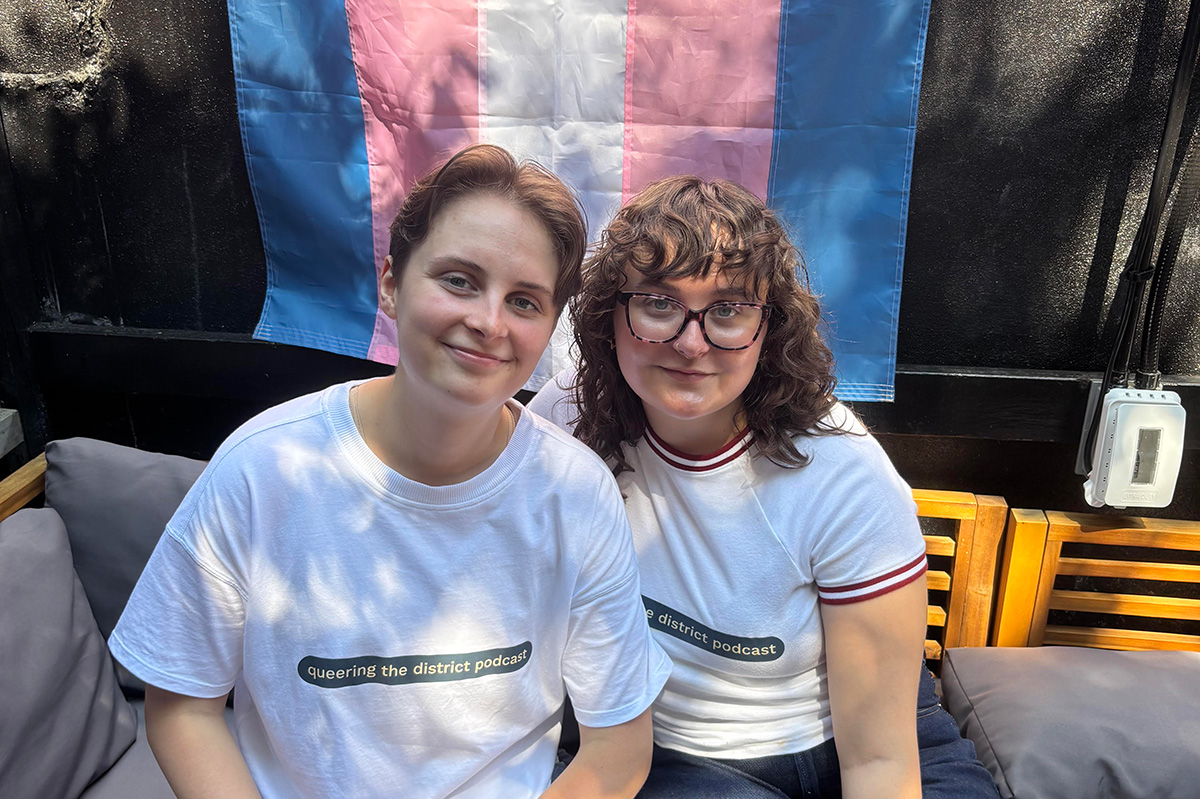
On June 25, as Pride month inched toward its end, three queer creators launched an ambitious project to honor the spaces that built D.C.’s LGBTQ community—and connect them to today’s queer life. The first episode of their podcast, Queering the District, hit streaming platforms that day, aiming to spotlight what host and co-creator Abby Stuckrath calls “third places”: bars, clubs, and gathering spots that have served as hubs for queer life across the city.
Each episode of the 10-part series delves into a different piece of D.C.’s queer past—from landmark clubs to untold personal stories—told through the voices of drag legends, activists, DJs, historians, and patrons who lived it. The show also threads together personal experiences from today’s community, bringing the listener on an auditory journey from Prohibition-era speakeasies to contemporary nights out at places like As You Are or Saints & Sinners.
Abby Stuckrath, alongside her sibling Ellie Stuckrath, and producer Mads Reagan, make up the podcast’s creative team. A recent journalism graduate of American University, Abby told the Blade that her passion for queer storytelling began during college—and that D.C. itself played a defining role in shaping her queer identity.
“I went to American University. I graduated last year and studied journalism. When I was in school, I always wanted to focus on queer stories – especially in D.C., because I’m from Denver, Colorado, I’ve never lived in a place like this before. D.C. has always just kind of been a place I call home when it comes to my queer identity.”
But breaking into the media to tell those stories wasn’t easy. Stuckrath quickly learned that editorial support—and funding—for queer-focused projects is limited. So she decided to do it her own way.
“I kind of found out that if you want to tell stories, you kind of have to do it on your own– especially when it comes to queer stories. There’s not a lot of people begging for us to talk about queer people and to pay you for it. So I was like, ‘Okay, let’s just do it on my own.’”
The idea for the podcast first took root in conversations with Ellie, Abby’s sibling and biggest supporter. Ellie had also moved to D.C. to find more space to explore and express their queer and gender identities. Together, the two began shaping a vision that would combine storytelling, sound design, and grassroots community input.
“I was like, ‘I don’t know what exactly I want to do yet, but I want it to be queer, and I want it to be about D.C., and it’s going to be called Queering the District, and we’re going to find out what that means.’ And Ellie is my biggest supporter, and my best friend. And they were like, ‘Hell yeah. Like, let’s do this.’ And so we decided to just do it together.”
The name stuck—and so did the mission. The team began researching queer D.C. history and found a city overflowing with stories that had rarely been documented, especially in mainstream archives.
“We started looking up the history of queer culture in D.C., and it kind of just clicked from there,” Stuckrath said. “I did not know anything about how rich our history is in the city until one Google search, and then I just kept learning more and more. I was kind of pissed because I studied gender studies in school in D.C. and didn’t learn shit about this.”
Season one focuses on the role of third places—non-work, non-home spaces where queer people could gather, exist fully, and build community.
“Third places have always been the epicenter of queer life… places outside of just your own personal home, because sometimes that isn’t a safe place. And of course, the work most commonly in the past and still today, isn’t a safe place for queer people to be full of themselves. So like, bars were the first place for queer people to really thrive and meet each other.”
To make the show participatory, Queering the District includes a twist: a voicemail line where anyone can call in and share a memory or question. The team calls the phone “Fifi”—a nod to the kind of retro guestbooks often used at weddings, but reimagined for queer nightlife and history.
“We wanted to find a way for people to share their stories with us anonymously… so even though we start in Prohibition, we wanted to connect it to now—like, those people who were singing jazz to each other in a white queer bar are connected to you singing karaoke on a Sunday night at your favorite gay bar. We’re all interconnected by this third place of queer bars in D.C.”
Those connections are emotional as well as historical. While building the series, one realization hit Stuckrath particularly hard: the immense loss of queer spaces in D.C., especially in neighborhoods that have since been heavily redeveloped.
“Every time I go to a Nats game, I think about, well, this just replaced five gay bars that used to be here. It used to be the home of Ziegfeld’s… Tracks, which was almost 2,000 square feet, with a volleyball court in the back, a fire pit, and iconic light show. I just didn’t know that we had that, and it made me sad for the queer elders that are in our city now who walk the streets and don’t see all those places they used to call home.”
That sense of loss—alongside the joy and resilience of queer community—is what the show aims to capture. As the podcast continues, Abby hopes it serves as both a celebration and an educational tool, especially for young LGBTQ people arriving in D.C. without realizing the queer foundations they’re walking on.
“D.C. is a unique city, and specifically young queer people who are hoping to move to the city—to know that you’ve got to know your history to be here. I hope this serves as an easier way for you to consume and learn about queer history, because queer history defines how we move in life.”
And for all the voices still left out, Abby is clear: this podcast is an open door, not a final word.
“This is a perfectly imperfect podcast. We should just be a starting point. We shouldn’t be the ending point.”
New episodes of Queering the District drop every Wednesday on all major platforms.
a&e features
Doug Spearman takes his chance
‘Noah’s Arc: The Movie’ debuted on Paramount+ last month
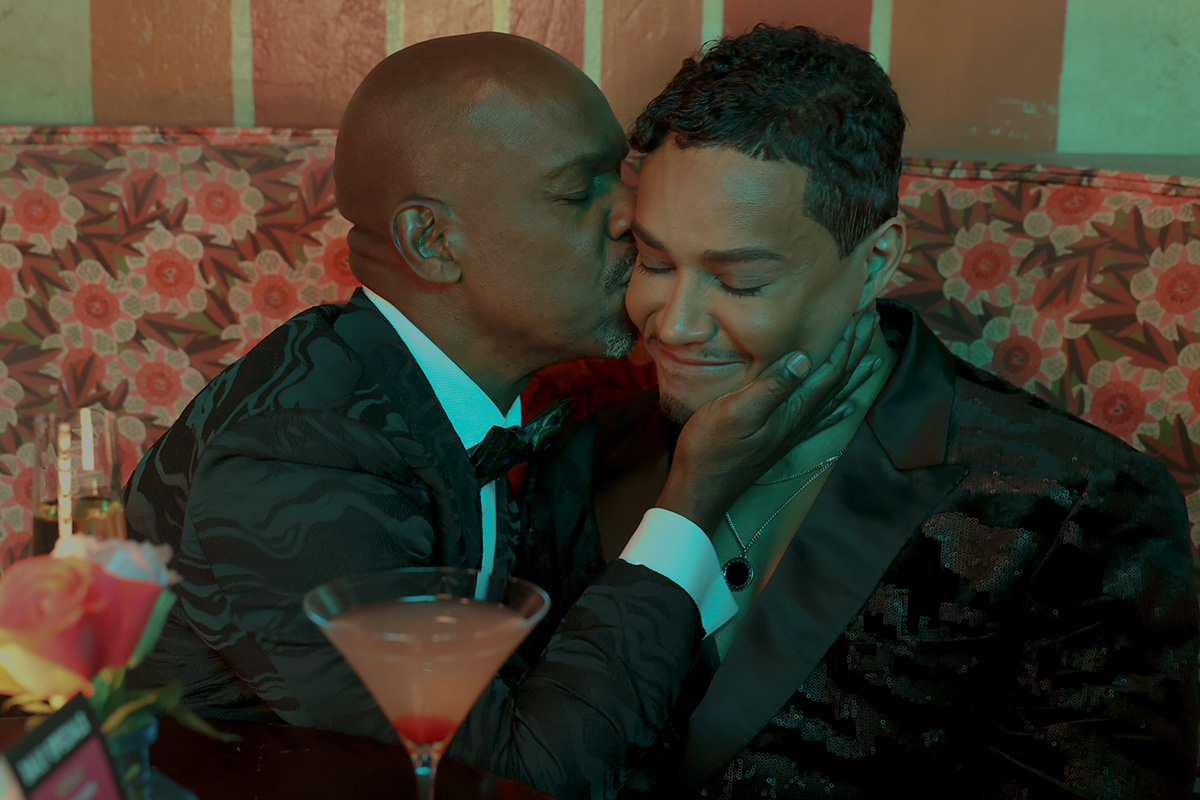
There’s no question that when Patrik-Ian Polk’s series “Noah’s Arc” premiered on Logo 20 years ago, it was a groundbreaking creation. The story of a group of Black gay men and their wonderful friendship. The titular arc was that of the cute main character, Noah (Darryl Stephens), and his close-knit circle of friends, including Chance played by gay actor Doug Spearman. This compelling and loving fraternity may, in fact, be what brought viewers back repeatedly, including a 2008 movie, “Noah’s Arc: Jumping the Broom,” as well as the 2020 “Noah’s Arc” short, and now, a new full-length feature “Noah’s Arc: The Movie,” debuting on Paramount+ on June 20. In the movie, filled with equal measures of laughs and tears, Chance, who has faced a devastating loss, finds his dependable friends there, ready to support and comfort him at a moment’s notice. I had the pleasure of speaking with Spearman the morning of the streaming premiere of “Noah’s Arc: The Movie.”
WASHINGTON BLADE: Doug, since the early 2000s, when the “Noah’s Arc” series premiered on Logo, you have been playing the character of Chance, including in the latest installment, “Noah’s Arc: The Movie.” What was it about Chance that appealed to you as an actor?
SPEARMAN: When Patrik (-Ian Polk) called me to ask me to play him (Chance), I was at JFK airport in the baggage claim, waiting for a suitcase. He explained what the part was. The thing that stuck out to me was the fact that Chance was in a long-term relationship with another Black man. And, they had a child; they had a 4-year-old daughter named Kenya. I had never seen two Black gay men raise a child on TV before. I thought it was the most revolutionary thing I’d ever seen. I immediately thought I’ve got to do this because that was something nobody had seen. I thought it was incredibly important to take the part.
BLADE: “Noah’s Arc: The Movie” was, once again, written and directed by Patrik-Ian Polk, who you just mentioned, is the creator of the entire franchise. What’s the secret to your long-standing working relationship?
SPEARMAN: [Laughs] the whole team, all of us, are like a band of brothers. We fight like brothers, we come together like brothers, we hash things out, we talk, because we’re all very different from our characters. I think the challenge of playing these guys and then uplifting these men, playing a part, especially something written by Patrik, is like solving a math equation. There’s always a challenge that’s enjoyable for me as an actor: to try to find out what it is that Patrik wants, and then how do I do it.
BLADE: I think you do a very good job of it.
SPEARMAN: Thank you very much
BLADE: In the years between “Jumping the Broom” and the new full-length movie, many changes have occurred, and the story addresses some of them, including gay widowhood, which is something that the aging community is now confronting, as well as mental health issues. Please say a few words about how you approached those subjects in the new movie.
SPEARMAN: I had a lot of loss in my life, right before we started shooting. Two months before we started shooting the first series, my mother died. I was going through the grief process through that whole first season. Since then, I’ve lost a lot of people in my life. In fact, when we started shooting the second season, the second week we were shooting, my ex died of a heart attack. I was having to fold that into what I was doing with my life on the set and off the set. You’ve got to show up and you’ve got to do your work. The first two seasons of “Noah’s Arc” are always tinged with the memory of grief. So, when I had to deal with the death that Chance faces (in the new movie), which is a significant death in his life, it wasn’t that hard to reach back, especially the scene in the graveyard. It was something that I unfortunately could pull from personal experience.
BLADE: Shifting gears, the movie features delightful cast surprises, including Jasmine Guy and TS Madison. Did you have a chance to interact with either or both when they were on set?
SPEARMAN: No, I didn’t have any scenes with Jasmine, and I missed her. I wish I had gotten to see her because I actually got to direct Jasmine for a CBS promo shoot for “Queen,” back in the early ‘90s. I had a huge crush on her when she was on “A Different World.” So, I really would have liked to reconnect. But TS and I got to see each other every day because I was in all her scenes. It was extraordinary being around somebody like that. That is one outspoken woman!
BLADE: Even though Beyoncé never makes an appearance in the movie, there’s a lot of talk about her. Would you say you are a Beyoncé fan?
SPEARMAN: Yes! I’m breathing! Yes, I’m a Beyoncé fan. I actually got the chance to meet her. I knew her mom. Her mom was extraordinary to me. She is in the second movie I directed. She also gave us a wedding gown to use in the very first scene of the movie. That family is extraordinarily important to me. Not only just to be a fan, but to be somebody who’s gotten to know them and work with them and see how hard they work. I don’t think anybody works as hard as Tina or Beyoncé.
BLADE: There was a recent news item about gay actor Benito Skinner of the Amazon Prime series “Overcompensating” being told not to bother auditioning for straight roles. As an out actor yourself, how important do you think it is for queer characters to be portrayed by queer actors, and vice versa?
SPEARMAN: Being queer is a multifaceted identity. There’s no one kind of queer person. I think finding the best actor that’s your first circle of casting. I think one of the joys about being an actor is that you get to play different parts. I play straight guys all the time. Dads and husbands and things like that. I think a lot of people are told not to do it. In fact, I wouldn’t be Chance if the actor who was originally cast as Chance hadn’t been pulled out of the series by his agents because they didn’t want him to play a gay character.
BLADE: That’s amazing! Thank you for sharing that. Without giving away too much, the ending of the movie is a little ambiguous, even ending with a question mark. If there was a “Noah’s Arc: The Movie” sequel, would you come back for that?
SPEARMAN: Yeah! A lot of it would depend on what Chance’s journey is going to be like. Patrik and I have conversations like that all the time. He’s very interested and supportive of input. I hope I would be, as we all would be, part of the creative growth with these characters. They live in Patrik’s head, and he writes them, but we’re the ones who have to flesh them out. It’s a conversation, it’s always a conversation.
BLADE: You are currently performing in Molière’s “The Imaginary Invalid” as part of the New Orleans Shakespeare Festival at Tulane. What has this experience been like for you?
SPEARMAN: It’s extraordinary! I started on stage when I was seven. There’s nothing like working with a live audience and having that immediacy. I’m working with an extraordinarily talented cast in a really great play, and I have some of the best scene partners I could ever want.
BLADE: Are there any upcoming film or TV projects you’d like to mention?
SPEARMAN: I’m still a writer, and I’m still a director, and I’ve still got scripts that I would like to make. I have a little something that’s a cross between “Treme” and “Bridgerton” that I want to do. I’m always trying to figure out what the next thing is.
a&e features
Visit Cambridge, a ‘beautiful secret’ on Maryland’s Eastern Shore
New organization promotes town’s welcoming vibe, LGBTQ inclusion
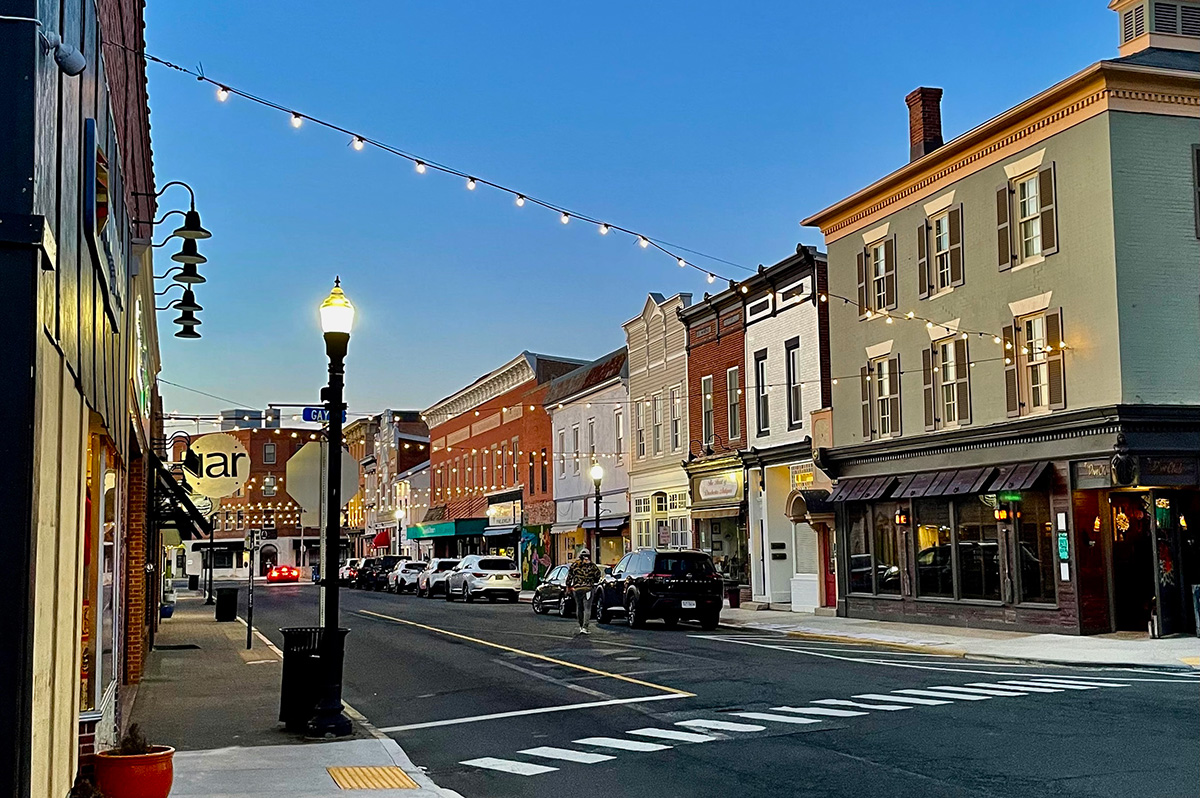
CAMBRIDGE, Md. — Driving through this scenic, historic town on Maryland’s Eastern Shore, you’ll be charmed by streets lined with unique shops, restaurants, and beautifully restored Victorian homes. You’ll also be struck by the number of LGBTQ Pride flags flying throughout the town.
The flags are a reassuring signal that everyone is welcome here, despite the town’s location in ruby red Dorchester County, which voted for Donald Trump over Kamala Harris by a lopsided margin. But don’t let that deter you from visiting. A new organization, Proudly Cambridge, is holding its debut Pride event this weekend, touting the town’s welcoming, inclusive culture.
“We stumbled on a beautiful secret and we wanted to help get the word out,” said James Lumalcuri of the effort to create Proudly Cambridge.
The organization celebrates diversity, enhances public spaces, and seeks to uplift all that Cambridge has to share, according to its mission statement, under the tagline “You Belong Here.”
The group has so far held informal movie nights and a picnic and garden party; the launch party is June 28 at the Cambridge Yacht Club, which will feature a Pride celebration and tea dance. The event’s 75 tickets sold out quickly and proceeds benefit DoCo Pride.
“Tickets went faster than we imagined and we’re bummed we can’t welcome everyone who wanted to come,” Lumalcuri said, adding that organizers plan to make “Cheers on the Choptank” an annual event with added capacity next year.
One of the group’s first projects was to distribute free Pride flags to anyone who requested one and the result is a visually striking display of a large number of flags flying all over town. Up next: Proudly Cambridge plans to roll out a program offering affirming businesses rainbow crab stickers to show their inclusiveness and LGBTQ support. The group also wants to engage with potential visitors and homebuyers.
“We want to spread the word outside of Cambridge — in D.C. and Baltimore — who don’t know about Cambridge,” Lumalcuri said. “We want them to come and know we are a safe haven. You can exist here and feel comfortable and supported by neighbors in a way that we didn’t anticipate when we moved here.”
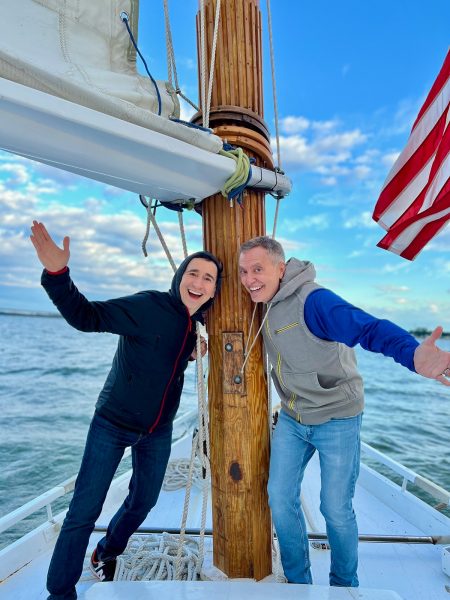
Lumalcuri, 53, a federal government employee, and his husband, Lou Cardenas, 62, a Realtor, purchased a Victorian house in Cambridge in 2021 and embarked on an extensive renovation. The couple also owns a home in Adams Morgan in D.C.
“We saw the opportunity here and wanted to share it with others,” Cardenas said. “There’s lots of housing inventory in the $300-400,000 range … we’re not here to gentrify people out of town because a lot of these homes are just empty and need to be fixed up and we’re happy to be a part of that.”
Lumalcuri was talking with friends one Sunday last year at the gazebo (affectionately known as the “gayzebo” by locals) at the Yacht Club and the idea for Proudly Cambridge was born. The founding board members are Lumalcuri, Corey van Vlymen, Brian Orjuela, Lauren Mross, and Caleb Holland. The group is currently working toward forming a 501(c)3.
“We need visibility and support for those who need it,” Mross said. “We started making lists of what we wanted to do and the five of us ran with it. We started meeting weekly and solidified what we wanted to do.”
Mross, 50, a brand strategist and web designer, moved to Cambridge from Atlanta with her wife three years ago. They knew they wanted to be near the water and farther north and began researching their options when they discovered Cambridge.
“I had not heard of Cambridge but the location seemed perfect,” she said. “I pointed on a map and said this is where we’re going to move.”
The couple packed up, bought a camper trailer and parked it in different campsites but kept coming back to Cambridge.
“I didn’t know how right it was until we moved here,” she said. “It’s the most welcoming place … there’s an energy vortex here – how did so many cool, progressive people end up in one place?”
Corey van Vlymen and his husband live in D.C. and were looking for a second home. They considered Lost River, W.Va., but decided they preferred to be on the water.
“We looked at a map on both sides of the bay and came to Cambridge on a Saturday and bought a house that day,” said van Vlymen, 39, a senior scientist at Booz Allen Hamilton. They’ve owned in Cambridge for two years.
They were drawn to Cambridge due to its location on the water, the affordable housing inventory, and its proximity to D.C.; it’s about an hour and 20 minutes away.
Now, through the work of Proudly Cambridge, they hope to highlight the town’s many attributes to residents and visitors alike.
“Something we all agree on is there’s a perception problem for Cambridge and a lack of awareness,” van Vlymen said. “If you tell someone you’re going to Cambridge, chances are they think, ‘England or Massachusetts?’”
He cited the affordability and the opportunity to save older, historic homes as a big draw for buyers.
“It’s all about celebrating all the things that make Cambridge great,” Mross added. “Our monthly social events are joyful and celebratory.” A recent game night drew about 70 people.
She noted that the goal is not to gentrify the town and push longtime residents out, but to uplift all the people who are already there while welcoming new visitors and future residents.
They also noted that Proudly Cambridge does not seek to supplant existing Pride-focused organizations. Dorchester County Pride organizes countywide Pride events and Delmarva Pride was held in nearby Easton two weeks ago.
“We celebrate all diversity but are gay powered and gay led,” Mross noted.
To learn more about Proudly Cambridge, visit the group on Facebook and Instagram.
What to see and do
Cambridge, located 13 miles up the Choptank River from the Chesapeake Bay, has a population of roughly 15,000. It was settled in 1684 and named for the English university town in 1686. It is home to the Harriet Tubman Museum, mural, and monument. Its proximity to the Blackwater National Wildlife Refuge makes it a popular stop for birders, drawn to more than 27,000 acres of marshland dubbed “the Everglades of the north.”
The refuge is walkable, bikeable, and driveable, making it an accessible attraction for all. There are kayaking and biking tours through Blackwater Adventures (blackwateradventuresmd.com).
Back in town, take a stroll along the water and through historic downtown and admire the architecture. Take in the striking Harriet Tubman mural (424 Race St.). Shop in the many local boutiques, and don’t miss the gay-owned Shorelife Home and Gifts (421 Race St.), filled with stylish coastal décor items.
Stop for breakfast or lunch at Black Water Bakery (429 Race St.), which offers a full compliment of coffee drinks along with a build-your-own mimosa bar and a full menu of creative cocktails.
The Cambridge Yacht Club (1 Mill St.) is always bustling but you need to be a member to get in. Snapper’s on the water is temporarily closed for renovations. RaR Brewing (rarbrewing.com) is popular for craft beers served in an 80-year-old former pool hall and bowling alley. The menu offers burgers, wings, and other bar fare.
For dinner or wine, don’t miss the fantastic Vintage 414 (414 Race St.), which offers lunch, dinner, wine tasting events, specialty foods, and a large selection of wines. The homemade cheddar crackers, inventive flatbreads, and creative desserts (citrus olive oil cake, carrot cake trifle) were a hit on a recent visit.
Also nearby is Ava’s (305 High St.), a regional chain offering outstanding Italian dishes, pizzas, and more.
For something off the beaten path, visit Emily’s Produce (22143 Church Creek Rd.) for its nursery, produce, and prepared meals.
“Ten minutes into the sticks there’s a place called Emily’s Produce, where you can pay $5 and walk through a field and pick sunflowers, blueberries, you can feed the goats … and they have great food,” van Vlymen said.
As for accommodations, there’s the Hyatt Regency Chesapeake Bay (100 Heron Blvd. at Route 50), a resort complex with golf course, spa, and marina. Otherwise, check out Airbnb and VRBO for short-term rentals closer to downtown.
Its proximity to D.C. and Baltimore makes Cambridge an ideal weekend getaway. The large LGBTQ population is welcoming and they are happy to talk up their town and show you around.
“There’s a closeness among the neighbors that I wasn’t feeling in D.C.,” Lumalcuri said. “We look after each other.”
-

 Virginia1 day ago
Virginia1 day agoDefying trends, new LGBTQ center opens in rural Winchester, Va.
-

 South Africa4 days ago
South Africa4 days agoLesbian feminist becomes South African MP
-
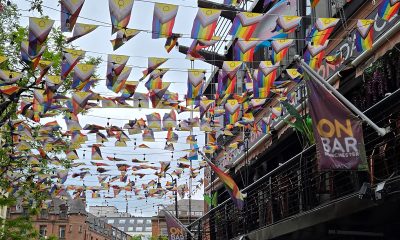
 Travel3 days ago
Travel3 days agoManchester is vibrant tapestry of culture, history, and Pride
-

 Opinions2 days ago
Opinions2 days agoUSAID’s demise: America’s global betrayal of trust with LGBTQ people

